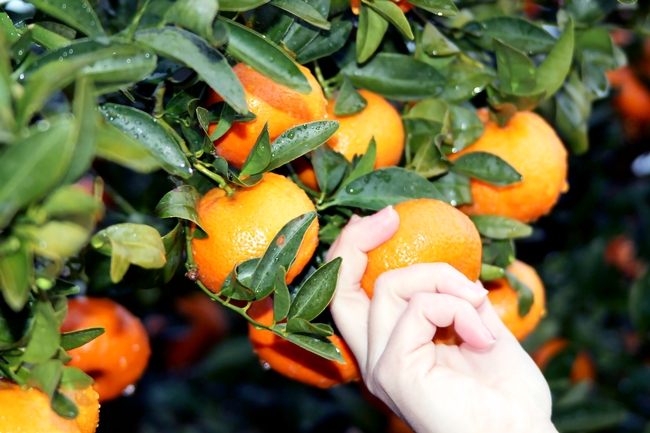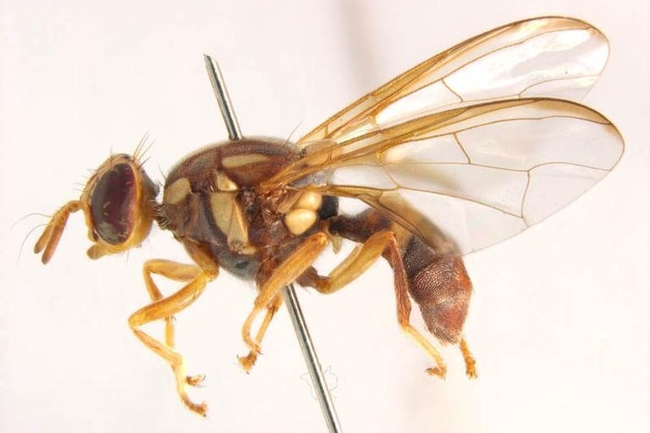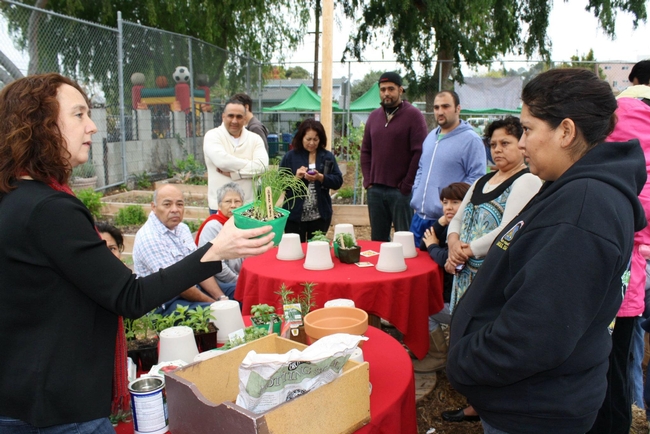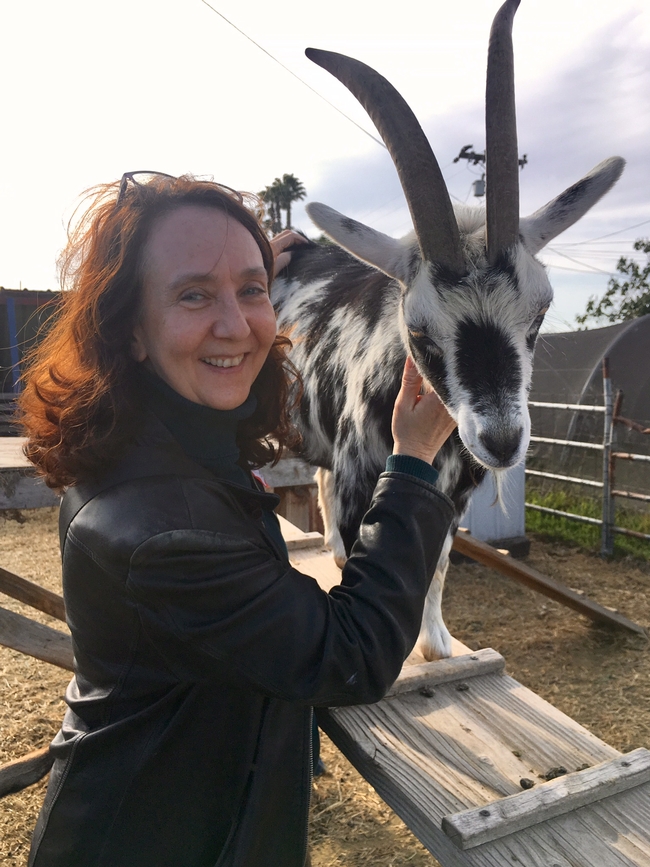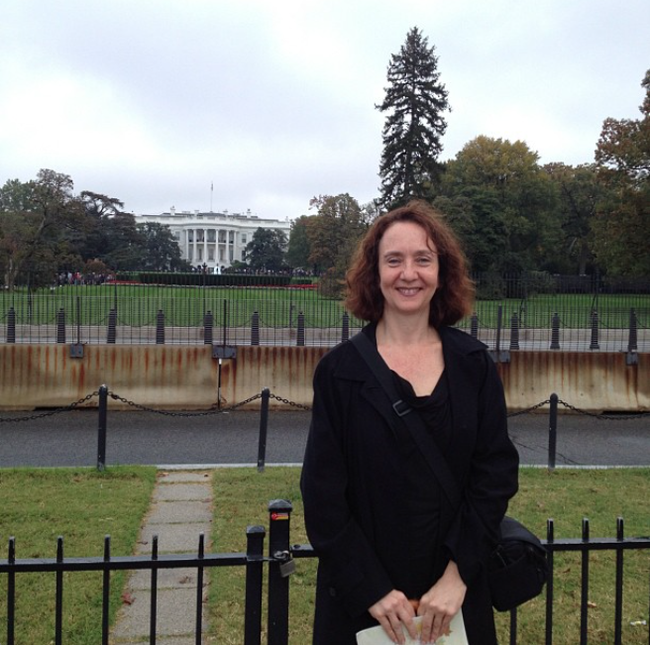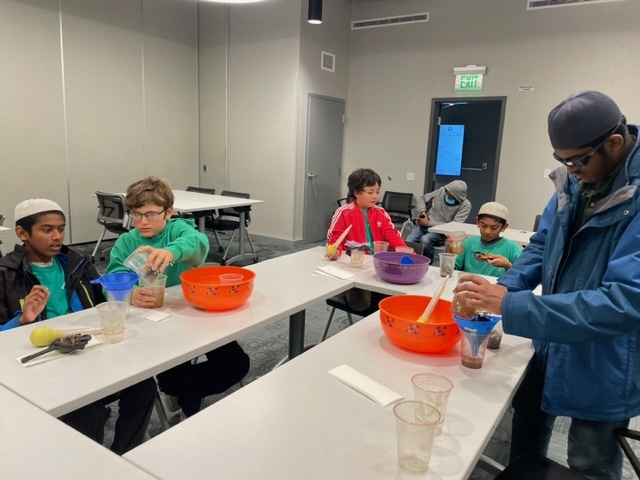
Posts Tagged: los angeles
First-ever Queensland fruit fly quarantine restricts moving homegrown produce
QFF quarantine in LA, Ventura counties among seven fruit fly quarantines statewide
Residents in multiple Southern California and Northern California counties should not move homegrown fruits and vegetables from their properties to help contain several species of fruit fly that can destroy crops and impact the livelihoods of local farmers.
With sharing and gifting of food integral to the holiday season, the California Department of Food and Agriculture is reminding people to heed the seven active fruit fly quarantines aimed at controlling the Mediterranean fruit fly, Oriental fruit fly, Tau fly and Queensland fruit fly. The links below describe quarantine zone boundaries:
- Mediterranean fruit fly: Los Angeles County, Leimert Park Area
- Oriental fruit fly: San Bernardino and Riverside Counties, Redlands and Yucaipa Areas
- Oriental fruit fly: Sacramento County, Rancho Cordova Area
- Oriental fruit fly: Contra Costa County, Brentwood Area
- Oriental fruit fly: Santa Clara County, Santa Clara Area
- Tau fly: Los Angeles County – Stevenson Ranch, Valencia, Santa Clarita Areas
- Queensland fruit fly: Ventura and Los Angeles Counties, Thousand Oaks Area
People within these zones should consume or process (i.e., juice, freeze or cook) their homegrown fruits and vegetables at the place of origin and not move them off their property. Uneaten produce should be double-bagged in plastic bags and disposed of in the landfill bin – not compost or green waste.
Queensland fruit fly threatens California citrus, other crops
The Queensland fruit fly (Bactrocera tryoni) quarantine is the first of its kind in the U.S. Although QFF was first seen in California in 1985, the recent detection of two adult males triggered the unprecedented quarantine action by USDA's Animal and Plant Health Inspection Service and CDFA.
“This pest has earned a bad reputation for wreaking havoc on fruit production in Australia, where it is native,” said Hamutahl Cohen, University of California Cooperative Extension entomology advisor for Ventura County. “Adult flies lay their eggs in fruit, and the eggs hatch into larvae that then feed on the fruit, causing damage.”
And while females of other fruit fly species live for only two or three months, QFF females are unique in that they can live up to a year, according to Cohen.
“Once QFF populations take root, they're challenging to manage because females can each lay up to 100 eggs per day,” Cohen said.
In addition to being highly adaptable to a variety of environmental conditions, QFF has more than 170 host plants – including a wide range of California commodities such as citrus, grape, strawberry, fig, avocado, apricot, peach, cherry, nectarine, plum, pear, apple, tomato and sweet pepper.
The threat to citrus is especially concerning, as Southern California growers continue to grapple with the specter of spreading huanglongbing (HLB) disease, which kills citrus trees. Cohen said residents of citrus-growing regions can do their part to help their neighbors and local economy by respecting quarantine restrictions.
“Growers are already dealing with other invasive species like Asian citrus psyllid [vector of HLB pathogen], so we as homeowners need to prevent the spread of fruit flies to reduce the burden on them,” she explained.
While a spike this year in the detections of multiple fruit fly species was likely caused by a host of factors, Cohen speculates that increased post-pandemic travel is helping to move the flies. And with holiday travel in full swing, she said it's important to practice “Don't Pack a Pest” principles.
“Invasive species often hitchhike on fruits and vegetables brought into California by travelers – that's why we often first find invasive species in urban and suburban backyards, and not on farms,” Cohen said. “Travelers entering the U.S. can visit dontpackapest.com to learn about which products they can and cannot bring back with them.”
To report a suspected infestation of fruit fly larvae in homegrown produce, call the CDFA pest hotline at 1-800-491-1899. Growers with questions and concerns are urged to contact their local agricultural commissioner's office.
Rachel Surls has cultivated a healthier LA County through gardens
UC Cooperative Extension advisor who promotes school gardens, urban agriculture to retire after 35-year career
A stroll through a leafy, green garden can give one temporary relief from life's harshness. During her career, Rachel Surls has used gardens to cultivate healthier communities, whether they are growing nutritious food or providing science lessons for students.
Over the past 35 years, Surls, University of California Cooperative Extension sustainable food systems advisor in Los Angeles County, has witnessed many changes – such as promoting public events on Instagram rather than typing and mailing press releases. A comforting and consistent presence has been the UC Master Gardener Program, part of UC Agriculture and Natural Resources.
“As I look back, the UC Master Gardener Program has been a constant in my work. It helps so many people,” said Surls, who joined UCCE as a school and community garden coordinator in 1988.
“My new job with UCCE-LA was my dream job. I organized community gardens around the county and supported teachers who wanted to start school gardens,” recalled the Michigan native, who plans to retire at the end of the year. “I had a bachelor's degree in agronomy and was freshly out of a stint with the U.S. Peace Corps in rural Honduras. My work there inspired me to pursue community development work related to gardening.”
Louisa R. Cardenas, trustee of Los Angeles County Natural History Museums, was a UC Master Gardener volunteer for 25 years.
“Among Rachel's many skills and assets are her willingness to listen to and consider ideas from Master Gardeners that eventually reach and empower Los Angeles County residents to grow food that supplements their nutritional needs,” Cardenas said.
To complement the nascent UC Master Gardener Program in Los Angeles County, Surls organized “Gardening Angels,” a cadre of volunteers to work with teachers and students to develop school gardens. She edited a guide for teachers, parents and volunteers to build gardens for children.
“I met Rachel in 1992 and was so blessed to come up through the ranks with her,” said Rose Hayden-Smith, UCCE emeritus advisor in digital communications in food systems and extension education. “We were in neighboring counties, and had many similar programmatic interests, including school gardens. Her research informed my work and was so helpful to me.”
Advancing food security, community nutrition
In 1994, after earning her master's degree from Cal Poly Pomona in agricultural science with a focus on agricultural education, Surls accepted a newly created position: UC Cooperative Extension urban horticulture advisor.
To retain Los Angeles County funding in 1992, the UCCE staff had become part of the county's Housing Authority/Community Development Commission. As the UCCE urban horticulture advisor, Surls was tasked with developing gardens at five public housing sites. At one of these locations, Carmelitos Housing Development in Long Beach, she worked with community partners to select landscape trees, hire a greenhouse contractor and design a horticulture job training program for public housing residents. This site became known as the Growing Experience Urban Farm.
“I'm pleased that 29 years later, the Growing Experience is still an active community farm where UC Master Gardeners offer workshops for the community,” Surls said.
In 1997, when George Rendell retired as director of UCCE in Los Angeles County, Surls applied for the job. For the next 14 years, she oversaw more than 70 employees and local programs, including the 4-H youth development program, which launched afterschool, hands-on learning for children.
Surls, who participated in 4-H herself as a child, worked closely with 4-H funders. She helped secure grants, contracts and gifts for 4-H as well as the UC Master Gardener Program and UCCE nutrition programs for projects that encouraged Angelenos to eat more fruits and vegetables.
“Rachel was incredibly creative and innovative as a leader,” said Hayden-Smith, who served as director of UCCE in Ventura County. “Rachel models a kind of quiet leadership that invites people into the process, honors the group and moves work forward in important ways.”
While working, Surls earned her Ph.D. in higher education administration at Claremont Graduate University in 2008, with an eye on pursuing other leadership roles. Instead, the global financial crisis inspired her return to working directly with Los Angeles County residents on urban gardening to reduce food insecurity.
To focus on outreach, the UCCE sustainable food systems advisor handed her UCCE director duties to Keith Nathaniel, UCCE 4-H advisor, at the end of 2011.
Developing, sharing resources for urban farming and gardens
In 2012, she organized colleagues within UC Agriculture and Natural Resources and community partners to study the needs of urban farmers and begin offering workshops for them. She led the development of an urban agriculture website, with resources covering business management, food safety, marketing and regulations. She served on the leadership board of the Los Angeles Food Policy Council and began advising cities on policies that would make it easier for residents to grow food.
“These have been my favorite and most productive years of my career,” Surls said.
Drawing on skills she began honing as an undergraduate at Virginia Tech as a news writer for the Virginia Extension Service, Surls co-authored a book about the history of agriculture in Los Angeles County, called “From Cows to Concrete: The Rise and Fall of Farming in Los Angeles.” She is currently working on a second book about urban farming in the U.S.
The Grow LA Gardens Initiative – which helps aspiring gardeners start their own gardens quickly – is one source of pride for Surls. Hundreds of people have taken the four-week course and, after participating, nearly 70% planted gardens.
In 2018, Surls was honored with the Bradford-Rominger award by the Agricultural Sustainability Institute at UC Davis for her work promoting community gardens, school gardens and urban agriculture.
With community gardens and school gardens now commonplace, Surls chuckles as she recalls veteran UCCE colleagues advising her to choose a more “serious” academic focus early in her career.
“It's gratifying to see so many people in academia working on farming in cities, school gardens and community gardens,” Surls said.
Advocating for equity
In 2022, while Surls was on sabbatical, she and Cardenas – the longtime UC Master Gardener volunteer – requested and received $100,000 from the Los Angeles County Board of Supervisors to hire an equity, diversity and inclusion coordinator and to fund outreach. This UC Master Gardener project championed by Supervisor Sheila Kuehl specifically reaches underserved populations within the county. “Such a significant achievement would not have been possible without Rachel's encouragement and support,” Cardenas said.
After she retires, Surls plans to volunteer her expertise for online training of UC Master Gardener volunteers statewide. To support their program efforts including outreach to the Spanish-speaking community and scholarships for underserved communities, Surls has pledged to give $5,000 as a matching gift to donations to the UC Master Gardener Program in Los Angeles between Giving Tuesday, Nov. 28, and Dec. 31 at https://ucanr.edu/LAmastergardener.
Los Angeles 4-H program cultivates future generation of water stewards
Ibrahim Yaaseen, member of the Palos Verdes Peninsula (PVP) 4-H club, grabs a hard hat and places it on top of his head. He then reaches for a bright orange safety vest and goggles to complete his safety gear outfit before joining the rest of his club members who are dressed the same.
The 4-H Youth Development Program of Los Angeles is already thinking about the future of water management and turned to the West Basin Municipal Water District in El Segundo to gain a deeper understanding of the precious resource we often take for granted.
The University of California 4-H Youth Development Program is managed through local Cooperative Extension offices. Through hands-on learning experiences, 4-H empowers youth to reach their full potential and enables them to build self-esteem, connect with their community and emerge as leaders.
Dee Keese, community club leader for the PVP 4-H club, coordinated an exclusive and interactive tour of West Basin's Edward C. Little Water Recycling Facility for the club's monthly marine biology meeting in December 2022.
Eager to inspire a stronger appreciation for water, Janel Ancayan, the West Basin's education coordinator, challenged the youth to build their own water filters using materials including fabric, a strainer, and a funnel. Since no specific directions were given, the activity challenged each student's science and engineering skills, such as carrying out an investigation, designing a solution, and communicating information with team members.
During the tour, students saw firsthand the impressive equipment and essential staff members that help to produce nearly 40 million gallons of recycled water each day. At the end of the day, students left with a deeper understanding of water resources and felt empowered to do their part to conserve water sources.
“We learned that recycling water helps to conserve our limited water supply and improves the environmental condition of our coastal waters,” said Yaaseen. “We ultimately learned a great deal about how to conserve water for future generations and that water conservation is one of the most important elements in combating climate change.”
Though Keese has volunteered as community club leader for 48 years, this is only the second time she has partnered with the West Basin. “I like to mix it up,” she said. “I'm always looking for community organizations and local businesses to partner with because these are places that the kids will likely interact with since they're nearby.”
Regardless, it's leaders like Keese and programs like 4-H that encourage water stewards like Ancayan. “I'm always so humbled and inspired when teachers make it a point to come out and visit our facility. In Southern California especially, [water] is not something we think about,” Ancayan said.
Even in a drought, water continues to flow from our faucets allowing us to shower, wash dishes or water the lawn. It's no wonder why water conservation is not always top of mind, especially for consumers. Educating the public, and targeting the younger generation, however, is a great start to prepare for the future.
West Basin offers a variety of educational programs that focus on different age groups. Many of them involve hands-on learning like the Teach and Test volunteer program, a partnership with the Surfrider Foundation, where high school students test samples of coastal water for bacteria, and then publicly share their findings to contribute to water quality monitoring in the area.
According to Yaaseen, the time spent with Ancayan at the West Basin was “one-of-a-kind” and provided a “golden opportunity” to learn why water recycling facilities are important. Ancayan hopes that her time spent with students ultimately influences them to consider a career in water.
“It's not a glamorous job but I'm really passionate about the next generation of water workers,” she said. “I hope that once they see the engineering, the excitement of these scientists that work in our laboratory and everything in between, that they start to think about water as a future career path.”
For those interested in joining 4-H, visit https://4h.ucanr.edu/Members/
To read this story in Spanish, please visit:
Programas 4-H de Los Ángeles forman a la futura generación de administradores de los recursos hídricos
https://ucanr.edu/blogs/blogcore/postdetail.cfm?postnum=57063
The Top Ten Ways to Conserve Water in Your Landscape and Garden in San Bernardino County
1. Select drought-resistant plants that grow well in your climate zone and microclimate (sun, shade, etc.). Try these search engines:
SelecTree: A Tree Selection Guide (calpoly.edu) Plant Search Database
Plant Search Database - Water Use Classification of Landscape Species (WUCOLS IV) (ucanr.edu)
For inland San Bernardino County: Home - Inland Valley Garden Planner
2. ‘Hydrozone': Place plants with similar water needs (very low, low, medium, high) together and water the hydrozones on different valves (or, if hand watering, water plants requiring the most water longer but not necessarily more often than other plants).
3. Make sure your irrigation system is operating properly (pressure, spacing, no weeds around heads, no broken parts, etc.).
4. Irrigate based on species and seasonal water needs (highest in summer) and soil type (sandy loam, clay loam, etc.).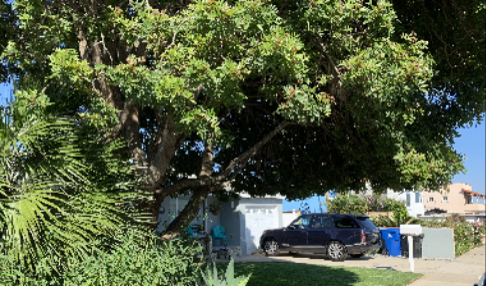
5. Irrigate slightly below the current root zone depth of your plants to encourage deep rooting into cooler soil: - 6”-8” for annuals, perennials, and turf - 8”- 1' for shrubs - 1' or deeper for trees
6. Water early in the morning when soil evaporation is minimal.
7. Control weeds. They compete with your garden plants for water.
8. Spread and maintain 2-4” of mulch around garden plants and trees (3-4” for wood chips, 2” for pebbles, decomposed gravel, etc.) keeping it a few inches away from tree trunks.
9. Avoid over-fertilizing. Too much nitrogen creates weak growth and the need for more water.
10. If you have a lawn and still want to keep it, water based on the UC ANR 'Lawn Watering Guide': http://ucanr.org/freepubs/docs/8044.pdf
Contact a trained University of California Cooperative Extension (UCCE) Master Gardener in San Bernardino County for more help! mgsanbern@ucanr.edu (fastest!) or: (909)387-2182 (leave a message for a return phone call)
Redlands trees
Invasive Trees to Avoid/Suggested Alternatives
Many previously “welcomed” urban tree species have outlived their stay, becoming invasive and crowding out other plants in our Southern California landscapes. You can help by avoiding planting these trees identified by various sources (including the California Invasive Plant Council) to be too aggressive and habitat/resource-depleting for further planting.
Invasive Trees to Avoid Planting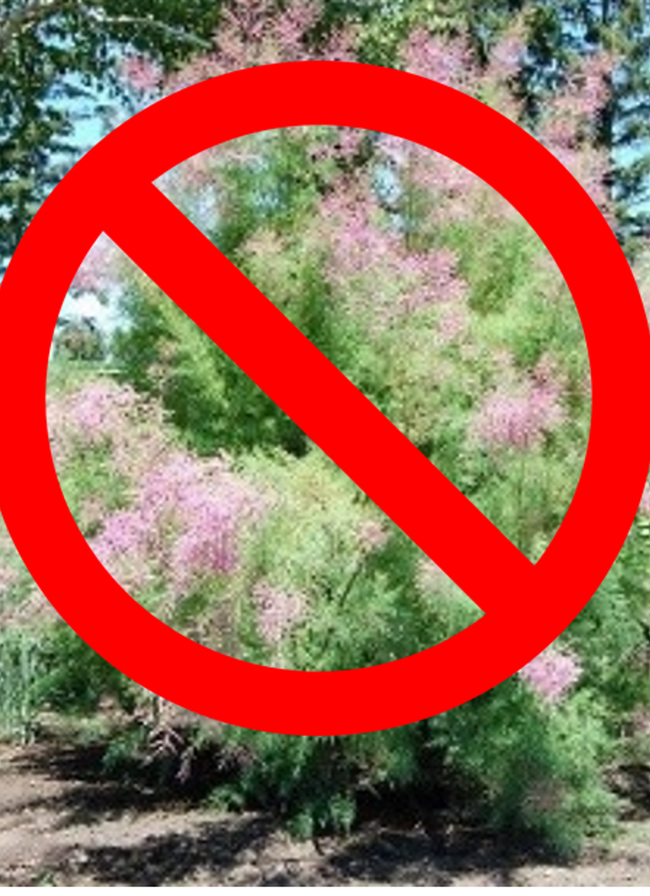
Athel (Tamarix aphylla)
Black Locust (Robinia pseudoacacia)
Blackwood Acacia (Acacia melanoxylon)
Brazilian Pepper (Schinus terebinthifolius)
Chinaberry (Melia azedarach)
Chinese Tallow Tree (Triadica sebifera)
English Hawthorn (Crataegus monogyna)
Peruvian Pepper Tree (Schinus molle)
Red Gum (Eucalyptus camaldulensis)
Russian Olive (Elaeagnus angustifolia)
Saltcedar (Tamarix ramosissima, T. gallica, T. chinensis)
Silver Wattle (Acacia dealbata)
Smallflower Tamarisk (Tamarix parviflora)
Tasmanian Bluegum (Eucalyptus globulus)
Plant These Instead
They are drought/heat resistant, low maintenance, and have no known significant pest or disease problems and are not currently overplanted). Find other suggestions here: https://www.cal-ipc.org/solutions/prevention/landscaping/dpp/?region=socal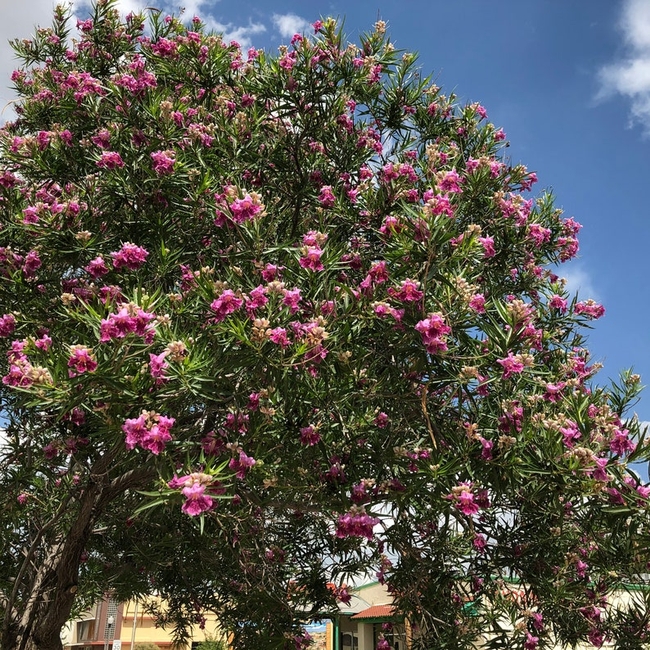
African Fern Pine (Afrocarpus falcatus) (formerly Podocarpus elatior)
Cascolote (Caesalpinia cacalaco Smoothie®)
Desert Willow ‘Bubba' (Chilopsis linearis)
Fringe Tree (Chionanthus virginicus)
Island Oak (Quercus tomentella)
‘Maverick' Mesquite (Prosopis glandulosa)
Mulga (Acacia aneura)
Netleaf Hackberry (Celtis reticulata)
Pink Chitalpa (x Chitalpa tashkentensis 'Pink Dawn')
‘Red Push' Pistache (Pistacia x ‘Red Push')
Thornless South American Mesquite (Prosopis x Phoenix)

